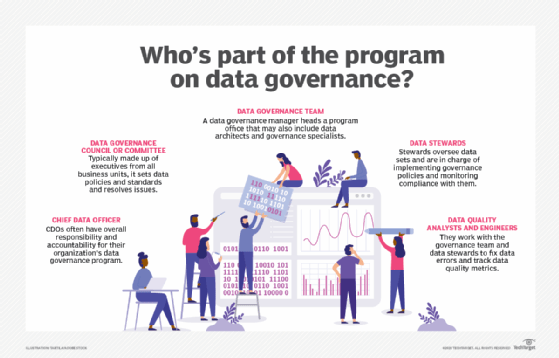
Fotolia
How data governance and data management work together
Data governance is an important part of data management. These recommendations will help build a strong complementary relationship between the two strategies.
Businesses in all industries view data as a strategic enterprise asset. Unlike other enterprise assets that have limited lifespans or are used once and replaced, data is durable and maintains its value.
Businesses also understand that strong data governance and data management practices are necessary to fully employ data's long-term, intrinsic value to the enterprise. And although data governance and data management are different activities, they must work together to improve overall business performance.
Data governance
Data governance is the strategic program that defines the roles, rules, processes and best practices an organization will follow to ensure the safety, quality and proper use of its data. Data governance provides a blueprint of controls to ensure the effective management of data at the enterprise level.
The inputs to data governance are standard IT community best practices and corporate, industry-specific and governmental regulatory framework specifications.
A data governance policy is a joint business and IT initiative, with both departments playing equally important roles. But data governance policies primarily focus on business outcomes. They are a set of technology-agnostic controls that are universally applied across an organization.
Data management
Data management is an IT-driven practice that focuses on the entire data lifecycle, including origination, validation, storage, availability, performance, security and maintenance. This includes reorganization utilities that ensure high-performance application access and security products that protect against unauthorized use. Data management covers a wide range of people, processes, tools and technologies.

The symbiotic relationship of data governance and data management
Although data governance provides a framework of controls for effective data management, it is just one component of the overall practice.
Dan Everett, VP of product and solution marketing at Informatica, accurately described the relationship between data management and governance in a blog post. He said data governance must be implemented to be effective, while data management facilitates policy enforcement.
Business size often determines how the data governance and data management responsibilities are organized and assigned. But size shouldn't be a determining factor for treating data as an enterprise asset, establishing effective data governance policies and performing high-quality data management.
Here are a few recommendations to help you ensure a mutually beneficial relationship between the two disciplines.
Organizational culture
Build an organizational culture of viewing data as an enterprise asset, which begins at the top of the organization chart. Getting upper management buy-in is critical.
Educating the organization on the benefits of effective data governance, management and usage is critical to the success of the program. The goal is to integrate the importance of data into the organizational fabric.
Effective communications
Establish strong communication paths between data governance and data management teams and business units. Business personnel provide critical insight to help create data usage and control policies.
A control that looks good in a policy document may not work as expected during operational implementation. Data management teams often identify opportunities for new controls and provide recommendations to improve existing policies. Data governance teams need feedback from data management and business personnel responsible for adhering to their policies.
Proactive approaches and reactive remedies to data quality
Proactive actions include fostering a data quality mindset throughout the organization and educating of IT and business personnel in data quality concepts.
The initial data governance policies and data management procedures will most likely have gaps that lead to data quality issues. In addition, ensuring enterprise data is correct and used properly throughout the organization is fluid by nature. In other words, "things change."
Data usage is highly dynamic and data governance controls and data management procedures may not always provide the guidance and best practices needed to guarantee data quality across all data stores. Feedback from IT and business personnel who interact with the data elements will help identify data quality issues.
Once a data quality issue is identified, the next steps are to determine the severity, scope of impact and root cause of the problem. Reactive remedies include new or updated data governance policies, data management procedural changes, application software corrections or additional education to prevent human error.







